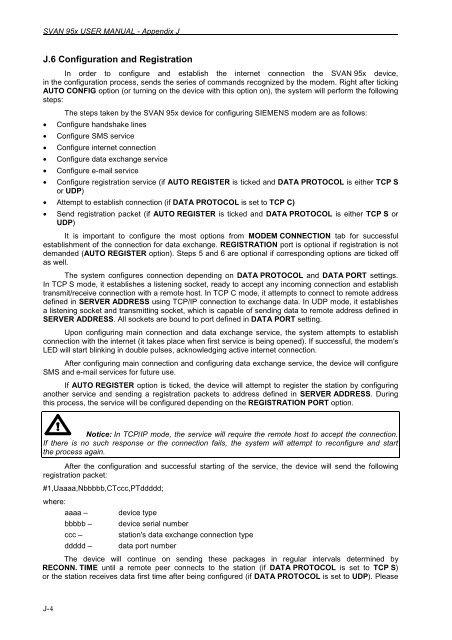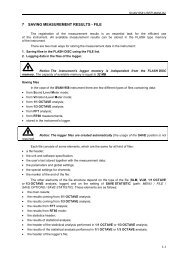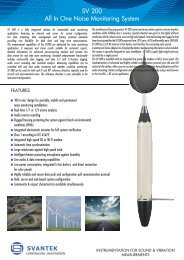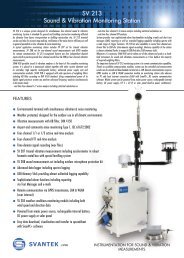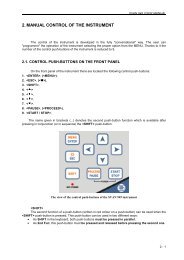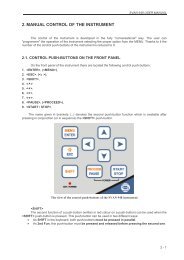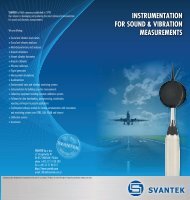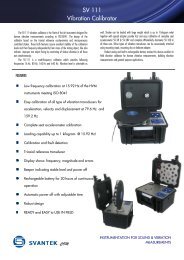95x Appendix J - Svantek
95x Appendix J - Svantek
95x Appendix J - Svantek
Create successful ePaper yourself
Turn your PDF publications into a flip-book with our unique Google optimized e-Paper software.
SVAN <strong>95x</strong> USER MANUAL - <strong>Appendix</strong> J<br />
.<br />
J.6 Configuration and Registration<br />
In order to configure and establish the internet connection the SVAN <strong>95x</strong> device,<br />
in the configuration process, sends the series of commands recognized by the modem. Right after ticking<br />
AUTO CONFIG option (or turning on the device with this option on), the system will perform the following<br />
steps:<br />
The steps taken by the SVAN <strong>95x</strong> device for configuring SIEMENS modem are as follows:<br />
• Configure handshake lines<br />
• Configure SMS service<br />
• Configure internet connection<br />
• Configure data exchange service<br />
• Configure e-mail service<br />
• Configure registration service (if AUTO REGISTER is ticked and DATA PROTOCOL is either TCP S<br />
or UDP)<br />
• Attempt to establish connection (if DATA PROTOCOL is set to TCP C)<br />
• Send registration packet (if AUTO REGISTER is ticked and DATA PROTOCOL is either TCP S or<br />
UDP)<br />
It is important to configure the most options from MODEM CONNECTION tab for successful<br />
establishment of the connection for data exchange. REGISTRATION port is optional if registration is not<br />
demanded (AUTO REGISTER option). Steps 5 and 6 are optional if corresponding options are ticked off<br />
as well.<br />
The system configures connection depending on DATA PROTOCOL and DATA PORT settings.<br />
In TCP S mode, it establishes a listening socket, ready to accept any incoming connection and establish<br />
transmit/receive connection with a remote host. In TCP C mode, it attempts to connect to remote address<br />
defined in SERVER ADDRESS using TCP/IP connection to exchange data. In UDP mode, it establishes<br />
a listening socket and transmitting socket, which is capable of sending data to remote address defined in<br />
SERVER ADDRESS. All sockets are bound to port defined in DATA PORT setting.<br />
Upon configuring main connection and data exchange service, the system attempts to establish<br />
connection with the internet (it takes place when first service is being opened). If successful, the modem's<br />
LED will start blinking in double pulses, acknowledging active internet connection.<br />
After configuring main connection and configuring data exchange service, the device will configure<br />
SMS and e-mail services for future use.<br />
If AUTO REGISTER option is ticked, the device will attempt to register the station by configuring<br />
another service and sending a registration packets to address defined in SERVER ADDRESS. During<br />
this process, the service will be configured depending on the REGISTRATION PORT option.<br />
Notice: In TCP/IP mode, the service will require the remote host to accept the connection.<br />
If there is no such response or the connection fails, the system will attempt to reconfigure and start<br />
the process again.<br />
After the configuration and successful starting of the service, the device will send the following<br />
registration packet:<br />
#1,Uaaaa,Nbbbbb,CTccc,PTddddd;<br />
where:<br />
aaaa –<br />
bbbbb –<br />
ccc –<br />
ddddd –<br />
device type<br />
device serial number<br />
station's data exchange connection type<br />
data port number<br />
The device will continue on sending these packages in regular intervals determined by<br />
RECONN. TIME until a remote peer connects to the station (if DATA PROTOCOL is set to TCP S)<br />
or the station receives data first time after being configured (if DATA PROTOCOL is set to UDP). Please<br />
J-4


